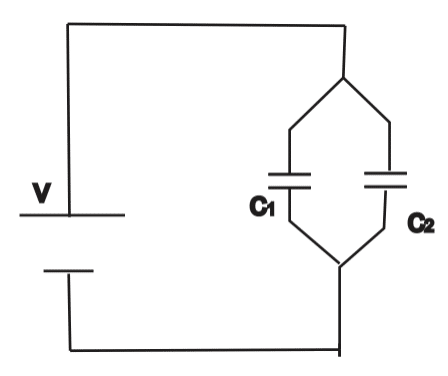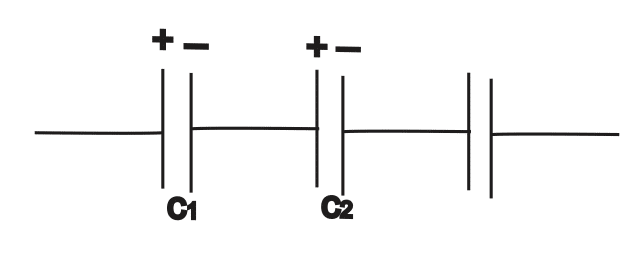Capacitors are always connected in series and parallel or both.
Parallel Connection
This is when capacitors are arranged side by side with the positive terminal joined to a common junction.

The total charge stored in a capacitor,
Q = Q1 + Q2 ; Q1 =C1v; Q2 = C2v
Therefore,
CV =C1v + C2v
Since V = V1 =V2, then
CV = C1V+C2V
or
C = C1 + C2 For parallel arrangement
When capacitors are in parallel,
- The same voltage is applied across each capacitor
- The charge Q is stored due to the current flowing and capacitance
- The total charge stored by the capacitors equals sum of charge stored by each capacitor
Series Connection
Capacitors are in series when they are joined end to end to form a line or loop.

- The same current flows through each capacitor do the same change
- Voltage through each capacitor depends on the capacitance of each capacitor
- Total voltage is the sum of the voltage across the capacitor
- Effective capacitance of the capacitor is given as
Example
Three capacitors of capacitance 2µF, 3µF and1µF are connected in a series in an electrical circuit. If a 500v dc source is connected across the capacitor. What is the total energyEnergy is the ability to do work. Energy exists in several forms such as heat, kinetic or mechanical energy, light, potential energy, and electrical energy. Units of Energy: The SI unit... More stored in the circuit.
Solution
\( \frac{1}{C} = \frac{1}{C_1} + \frac{1}{C_2} \)= \( \frac{1}{2} + \frac{1}{3} + \frac{1}{1} \)
= \( \frac{11}{6}\)
Therefore,
C = 0.55µF = 0.55 x 10-6
Energy stored, E = \( \frac{1}{2} \scriptsize cv^2 \)
= \( \frac{1}{2} \scriptsize \; \times \; 0.55 \times 10^{-6} \times 500 \times 500 \)
=0.0625J
=6.25 10-2 J



Responses